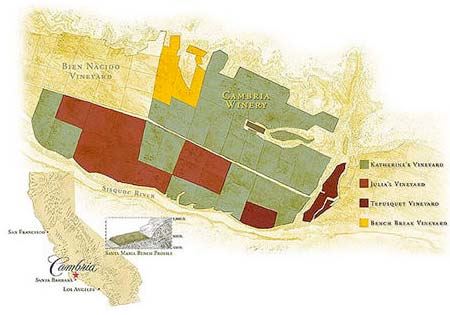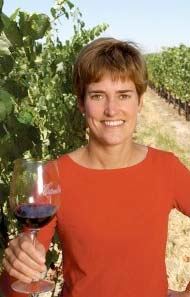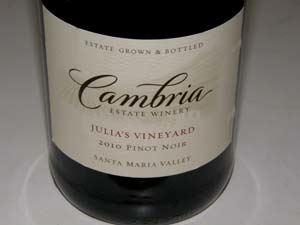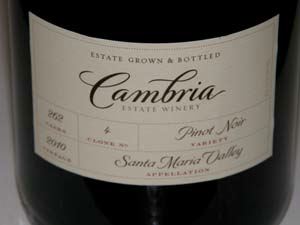Cambria Estate Winery
This Kendall-Jackson property is located on the Santa Maria Valley Wine Trail and covers more than 1,400
acres. Barbara Banke, along with her spouse, the now-deceased Jess Jackson, established Cambria in 1986
after purchasing what was originally known as the Tepusquet Vineyards. This benchland is located between
the Sierra Madre Mountains and the Sisquoc River, and was originally denoted as Tepuzli, a Chumash Indian
term meaning “copper coin.” Spanish settlers later renamed it Rancho Tepusquet. The original owners of the
rancho, part of a 1838 Mexican land grant, were the Olivera family who raised cattle and planted Mission
grapes.
According to Salud! The Rise of Santa Barabara’s Wine Industry (Victor Gurachi, 2004), Tepusquet Vineyards
was owned by Luis and George Lucas and partner Al Gagnon, and consisted of a 2,700-acre ranch with 1,700
acres of developed vineyard dating to the 1970s. The Lucas brothers eventually fell on hard financial times
and decided to sell the ranch. They spurned a generous offer from Beringer because of their concern that
Beringer would “bury its quality grapes in their Napa Ridge second label and not give recognition to Santa
Barbara County.” By 1985, Kendall-Jackson was producing 63,000 cases of Chardonnay per year from the
Santa Barbara County region and Jess Jackson wanted to expand his production of Chardonnay to produce a
vintner’s reserve based on Tepusquet Chardonnay grapes. Eventually, the Lucas brothers sold a sizable
portion of the Tepusquet Vineyards to Jackson and Banke, who partnered with the Robert Mondavi Winery that
valued the Tepusquet Vineyard’s Cabernet Sauvignon and Sauvignon Blanc grapes.
Cambria Estate vineyards are located 17 miles inland from the Pacific Ocean and sit at 400 to 800 feet above
sea level. They are planted in sandy, alluvial soil that is well-drained which limits yields and drives the vines to
concentrate their energy on fruit maturation. The cool climate with moderating maritime influences from the
east-west orientation of the valley leads to a long growing season and desirable acid retention.
There are currently five estate vineyards at Cambria, with Katherine’s and Julia’s named after Banke’s
daughters. Along with Tepusquet Vineyard, these three vineyards supply 90% of the grapes to the winery. A
smaller contribution comes from Bench Break Vineyard and Rae’s Vineyard. The winery is best known for
three wines: the Julia’s Pinot Noir, the Katherine’s Chardonnay and the Tepusquet Syrah. Julia’s Vineyard
grapes are especially prized by local wineries and grapes have been sold to such notable wineries as
Benjamin Silver Wines, Bonaccorsi, Byron, Foxen, Hitching Post, and Lane Tanner.
There are a total of 483 acres of Pinot Noir planted on the Estate including 4, 5, 12, 15, 23 2A, 115, 667, 777,
828, and Julia’s, creating an attractive mix of clonal diversity. Over 300 acres of the Estate are available for
future development. All grapes from the Estate are certified sustainable by the CCSW program.
The Julia’s Vineyard Pinot Noir is a standard bearer for Central Coast Pinot Noir. Anchored by one of the
oldest commercial plantings of Pinot Noir in Santa Barbara County (1974), it contains eight different clones. It
is produced in large enough quantities to be widely available in the retail marketplace and is value priced at
about $25. What Steve Heimoff said in 2009 holds true today: “Julia’s Vineyard Pinot Noir is the best Pinot
Noir at this price on the market.”
What is less well known and advertised is that Cambria Estate Winery also specializes in limited production,
distinct clonal Pinot Noirs. If you have the interest, tasting the clonal Pinot Noirs side-by-side can offer a good
education in clonal differences since the wines are vinified in an identical manner. These wines are sold
primarily through the winery’s tasting room, to wine club members, and to a mailing list, but you can call the
winery at 888-339-9463 for availability.
Denis Shurtleff was appointed winemaker in 2002. She is a graduate of Cal Poly San Luis Obispo who started
her career as a lab technician at Corbett Canyon. She eventually worked her way up to winemaker and spent
sixteen years at Corbett Canyon. She then joined winemaker Fred Holloway at Cambria and eventually
replaced him. All Cambria wines are grown, produced and bottled on the Estate.
I recently sampled the 2010 Cambria releases of Pinot Noir. Denis noted that an unusually cool summer and
fall prolonged the already long growing season in 2010 and harvest did not begin until the middle of
September. A heat wave struck the Santa Maria Valley quickly ripening the rest of the Pinot Noir. The grape
clusters and berries were small, resulting in rich and concentrated flavors with strong acid levels.
The winemaking regimen for the single clone Pinot Noirs was as follows. The clusters were de-stemmed into
half-ton picking bins. The must was shoveled into new French oak barrels that had one head removed, thus
converting them into “open top” fermenters. The must was then cool soaked for a week and primary
fermentation ensued in the barrels. The must was punched down by hand twice a day and then pressed off to
dryness. Finally, the wine was returned to French oak barrels for 10 months of aging.
The Cambria Estate Winery website is extremely informative and well-organized. Visit www.cambriawine.com.
The tasting room on the Cambria Estate property is located at 5475 Chardonnay Lane in Santa Maria and is
open daily from 10:00 to 5:00.

2010 Cambria Estate Winery Julia’s Vineyard Santa Maria Valley Pinot Noir
14.6% alc., pH 3.59, TA 0.54, $25. Clones 4, 2A, 23, 667,
115, 12, 5 and 777. Aged 8 months in 26% new French oak barrels.
Week-long cold soak for optimum color and flavor extraction.
·
Moderately dark reddish-purple color in the glass. Beautifully
perfumed with aromas of boysenberry pie glaze, dark cherries, black
grapes, spice and just a hint of mocha. Very tasty core of moderately
dark red, blue and black berries with an earthy undertone, well-integrated oak
and a polished mouth feel. A quintessential Santa Maria Valley wine that has
respectable power, good finishing length and enough spirit to be thoroughly
satisfying. Very good.
2010 Cambria Estate Winery Clone 115 Santa Maria Valley Pinot Noir
13.8% alc., pH 3.48, TA 0.50, 261
cases, $52. Aged 10 months in 100% new French oak barrels.
·
Medium reddish-purple color in the glass.
Subdued, but likable aromas of dark cherries, berries and spice. An appealing rush of dark red fruits saturates
the entry, expands in the mouth, and finishes extremely long and powerful. Hints of herbs and edible flowers
add interest. Lithe, with supple tannins and appealing crispness. Very good.

2010 Cambria Estate Winery Clone 4 Santa Maria Valley Pinot Noir
14.9% alc., pH 3.60, TA 0.57, 262 cases, $52. Aged 10 months in 100%
new French oak barrels.
·
Moderately dark reddish-purple hue in the
glass. A complex and alluring nose offers scents of black cherries,
spice, wood shop, mushroom and sandalwood. Polished and very
appealing with impeccable balance, offering flavors of fresh, spicy black
cherries, with a hint of toasty oak in the background. Lavish, seductive
and satiny, this is pure pleasure. Given a choice, I always seem to prefer single
Pommard clone wines over single Dijon clone wines.
2010 Cambria Estate Winery Clone 667 Barbara’s Santa Maria Valley Pinot Noir
14.9% alc., pH 3.35, TA
0.65, $80. The winery’s pinnacle wine made from owner Barbara Banke’s favorite grape. Aged 10.5 months in
100% new French oak barrels.
·
Dark reddish-purple color in the glass. Very subdued aromas of black
raspberries, aged wine cellar and oak. Rich, dense and deeply flavored with copious amounts of black
raspberry and blackberry fruit and a riff of complimentary oak spice in the background. The lush fruit extract is
somewhat buried in the structural tannins and the wine will need more time in the bottle to correct this. The
finish is of special note with the dark fruited aromatics returning for several extended encores. This is a
Cabernet drinker’s Pinot that is bit over the top for me, but is very well made in its style. Solid now, but may
deserve more accolades in a few years. Good.






